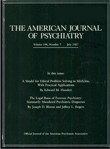Boundaries of Major Depression: An Evaluation of DSM-IV Criteria
Abstract
OBJECTIVE: Little is known about the boundaries between major depression and milder subsyndromal depressive states. With respect to depressive symptoms, does DSM-IV “carve nature at its joints”? METHOD: In personally interviewed female twins from a population-based registry, the authors examined whether a range of values along three dimensions of the depressive syndrome assessed in the last year (number of symptoms listed in DSM-III-R under diagnostic criterion A for major depressive episode, level of severity or impairment required to score symptoms as present, and duration of episode) predicted future depressive episodes in the index twin and risk of major depression in the co-twin. RESULTS: An increasing number of criterion A symptoms predicted, in a monotonic fashion, a greater risk for future depressive episodes in the index twin as well as a greater risk for major depression in the co-twin. No such consistent relationship was seen with duration of episode. For severity, a single monotonic function predicted risk in the co-twin, while index twins with severe impairment had a substantially higher risk for future episodes than did those with less severe impairment. Four or fewer criterion A symptoms, syndromes composed of symptoms involving no or minimal impairment, and episodes of less than 14 days' duration all significantly predicted both future depressive episodes in the index twin and risk of major depression in the co-twin. CONCLUSIONS: The authors found little empirical support for the DSM-IV requirements for 2 weeks' duration, five symptoms, or clinically significant impairment. Most functions appeared continuous. These results suggest that major depression—as articulated by DSM-IV—may be a diagnostic convention imposed on a continuum of depressive symptoms of varying severity and duration. (Am J Psychiatry 1998; 155:172–177)



